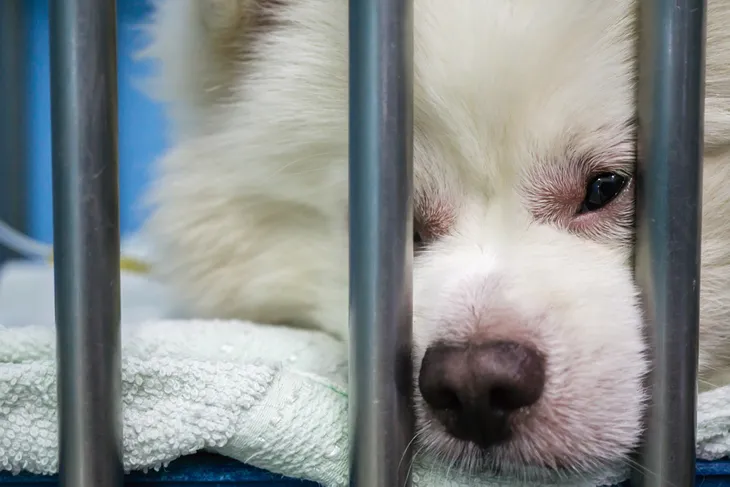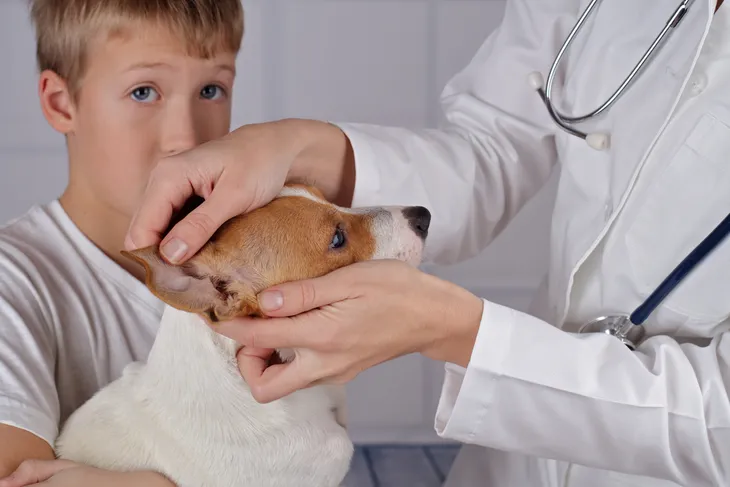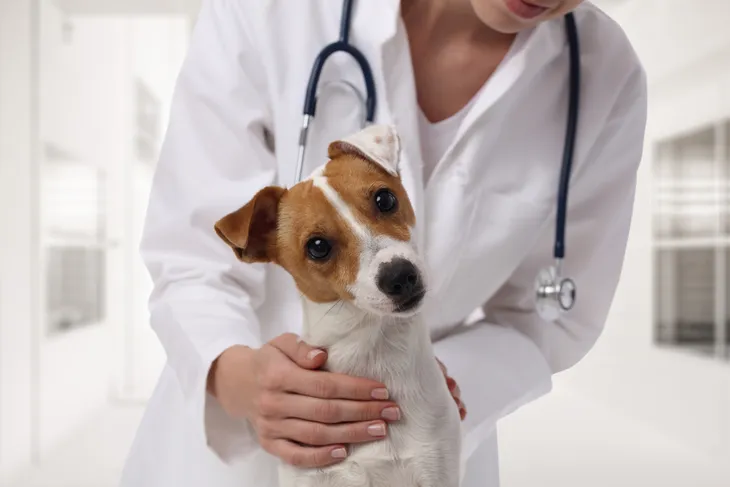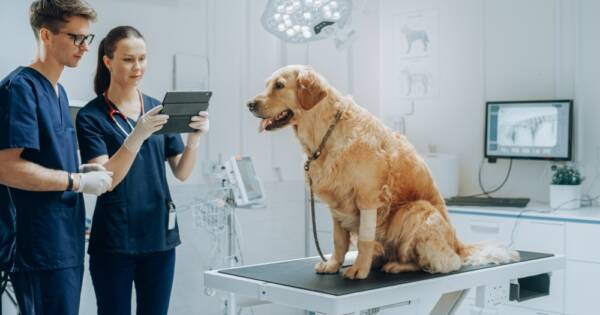Blepharitis is the clinical term for the inflammation that can affect the outer skin and connective tissues of a dog’s eyelids. The primary condition also frequently results in secondary inflammation that affects the eyelid’s inside surface.
Many different factors can contribute to blepharitis in dogs. Some dogs are born with it, while others develop it after an allergic reaction or a bacterial infection. Parasites, eye diseases, viruses, and burns or lacerations can also cause blepharitis, though no cause can be determined in a small percentage of cases.
Symptoms of Blepharitis in Dogs
Blepharitis in dogs typically presents with at least a few of the following symptoms (note: treatment options are listed after the 8 symptoms below):
Symptom: Skin Change in the Eye Area
You may notice changes to the consistency and appearance of the skin and external tissues on and around your dog’s eyelids. Dogs with blepharitis typically develop scaly skin around their eyes, which often becomes flaky. Redness and swelling will accompany these skin symptoms, and the eye may cause your dog obvious discomfort. For example, many dogs with blepharitis experience spasms of uncontrolled blinking or squinting, known as blepharospasms.
These physical symptoms are the primary signs of blepharitis, and will be present in practically all cases.
Symptom: Itchy Eyes
The red, swollen, flaky, scaly skin will be itchy to your dog, and as such, you may notice your dog scratching its eyes. This scratching can become very intense, and in many cases, it causes secondary complications as your pet attempts to relieve the itching. These efforts can result in damage to adjacent tissues and eye injuries, and as such, you should take your pet to see your veterinarian so the underlying itching can be treated.
Symptom: Discharges From the Eye
Your dog may discharge fluid from its eye, and these discharges are more likely to occur if your pet is intensely scratching at the inflamed eyelid. However, they can also occur even in the absence of scratching.
Such discharges can take several forms. Some are clear, while others are thicker and contain higher concentrations of mucus. Because accompanying infections are common, you may also notice discharges of pus coming from your dog’s eye. Veterinarians classify these eye discharges in various ways, according to their contents: watery, mucoid (containing mucus), or purulent (containing pus).
Symptom: Thickened Eyelids
As the condition continues to develop, your dog’s affected eyelid may thicken, both on the outer side and on the inside. This thickening of the eyelid is medically known as edema, which is a term that’s used to describe any abnormal buildup of fluid in a bodily tissue.
Minor edemas may be difficult to notice and aren’t likely to cause your dog any discomfort. However, more intense edemas will be obvious, and may interfere with your dog’s vision if the swelling becomes pronounced enough.
Symptom: Excoriation of Eyelid Skin
Dogs don’t understand that they are making things worse for themselves when they scratch eyelids affected by blepharitis; they are simply trying to relieve their itching and discomfort the only way they know how. Unfortunately, because the scratching is often so intense, it can result in the excoriation, or scraping off, of the skin around the eyelid. This can leave the eyelid in a raw, vulnerable state, and make it more prone to secondary infection.
Symptom: Hair and Skin Pigmentation Losses
Other itching-related symptoms can affect the dog’s hair and the skin pigmentation around the affected eyelid. Your dog’s constant scratching can effectively result in it tearing the fur right off its own face, leaving exposed skin in its place. In other cases, your dog can scratch itself so deeply that it scrapes away its own skin pigmentation, causing noticeable discoloration.
Alternately, changes to hair and skin pigmentation can simply result from the longstanding, untreated presence of inflammation. The swelling of the eye affects the performance of adjacent tissues, potentially leading to fur and pigmentation losses.
Symptom: Pustules, Papules, and Conjunctivitis
Blepharitis is frequently accompanied by pustules, papules, and conjunctivitis. Pustules are small, inflamed lesions that are elevated from the surface of the skin and contain pus. Papules are similar, in that they present as small elevated lesions, but they do not contain any pus. Conjunctivitis, or pink eye, affects the appearance of eyelids, causing them to swell and thicken; eyes also become bloodshot and pink or red in appearance, and may generate a goopy liquid discharge.
Symptom: Cornea Inflammation
One of the more serious symptoms of blepharitis in dogs is inflammation of the cornea. The cornea is the thin, transparent covering the coats the surface of the eye. Dogs with blepharitis can develop inflammation of this vital protective layer, which can in turn cause a type of vision impairment known as keratitis. Corneal inflammation can be very painful to the dog, causing excessive watering of the eye. Your dog may also attempt to scratch its cornea to relieve the pain, which can result in serious damage.
Treatment of Blepharitis in Dogs
The prognosis of a case of canine blepharitis depends on its underlying cause. Some dogs respond well to treatment, while no cure is possible in other cases. Your vet is likely to recommend:
Treatment: Specialized Collars
If your dog’s case of blepharitis is relatively minor and does not yet display any complications, your vet may recommend a conservative approach that involves the use of an Elizabethan collar (commonly called a “cone” or a “cone of shame”). The placement of this collar will physically inhibit your dog from scratching its eye, which is the primary cause of complications. Preventing the scratching may be enough to allow the condition to clear up on its own.
Treatment: Elimination of Allergens
Some cases of blepharitis occur after your dog comes into contact with environmental allergens that irritate its eyes and the surrounding skin. In other instances, these allergens are not environmental, but are actually dietary. If your vet suspects foodborne allergens as the cause of your pet’s blepharitis, he or she may order tests to determine what your dog is allergic to, and advise you on how to safely eliminate that allergen from your pet’s diet.
Treatment: Antibiotics
Topical and systemic antibiotics may be needed to bring secondary infections under control. It is very common for dogs with blepharitis to develop accompanying bacterial skin infections, and these infections must be treated in order to have any hope of getting the underlying condition to improve. Your vet may need to order lab tests to determine exactly what type of bacteria is infecting your dog’s eye so that an effective, targeted antibiotic drug can be prescribed.
Treatment: Surgery
In advanced and extreme cases of blepharitis, and in cases in which the condition is affecting your dog’s vision, surgery may be recommended. Surgical interventions have varying degrees of success, depending on the underlying cause of the eye inflammation and the presence (or absence) of secondary infections. As with other forms of canine surgery, these treatments carry risks of post-surgical infection, as dogs may scratch at the treated area. An Elizabethan collar will likely be used as a safeguard against this possibility.















